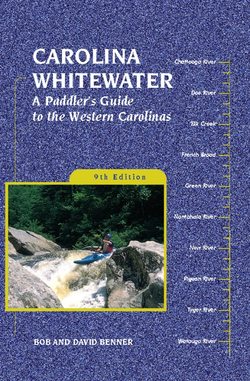Читать книгу Carolina Whitewater - David Benner - Страница 9
ОглавлениеIntroduction
This guide, originally written for the recreational open boater, has been expanded to include stretches of water that will challenge the most advanced decked canoe and kayak paddler. Much of the water, however, is suitable for the novice paddler. The more difficult runs are not recommended for those thrill seekers who wish to try their wings. One’s wings need to be fully grown before attempting these highly technical, and quite often dangerous, stretches. In classifying rapids it is difficult to remain totally objective because judgment is generally relative to experience.
As the sport of paddling grows, more and more clubs are being organized with paddling as their main interest. Some longtime paddlers question the need for such growth or organization, and rightly so, but this is one of the few safe proving grounds available for aspiring paddlers. It is primarily through clubs that paddlers can obtain competent instruction to improve skills and learn safe paddling practices. Also, it is only by organization that our free-flowing rivers are going to be saved for future generations.
Information on safety has been included because of certain hazards involved in the sport. Hopefully the suggestions made will lessen the possibilities of accidents other than normal swampings and dunkings.
Along with these suggestions are rules that will be helpful for the paddler who decides that Labor Day shouldn’t necessarily mean the end of the season. More and more paddlers are venturing forth in the middle of winter to experience a completely different world. The risks increase as the air and water temperatures decrease. A familiarity with certain facts relating to exposure can cut down considerably on these inherent risks.
The average paddler in North Carolina seems to harbor the idea that one has an inalienable right to paddle on any stream that has enough water to float a canoe. This most certainly is a misconception under the present interpretation of state law, and an attempt to clarify what the rights of the paddler may be is discussed.
An explanation of the book’s overall format has been included so that the reader can fully understand the organization of the materials on the streams and the various sections into which they may be divided. In Canoeing White Water, Randy Carter established such an understandable outline in describing rivers that it has been followed very closely.
This book is organized into six chapters. The first four consist of groups of rivers in neighboring counties in the foothills and mountains of the state: these are further grouped by watershed. The fifth chapter contains the Chattooga, the Chauga, the Doe, and the Tyger, located in neighboring states. The Haw River, a stream of the Piedmont, has also been included because of its extreme popularity. The last section has very little whitewater but has been included to offer the paddler a selection of some 200 miles suitable for camping trips.
Though the maps included is this ninth edition of Carolina Whitewater are as accurate as any can be (they are based primarily on county road maps), some amount of error is to be expected. Using these maps in conjunction with county maps will help you set shuttles quickly and accurately.
The original reason for undertaking such a work as this was to provide a source of information for those who would like to take their pleasure in paddling the many beautiful rivers of the western Carolinas. The effort will have been worthwhile if any small portion of the great pleasure the authors have experienced on the several hundred miles described herein is imparted to the reader.
